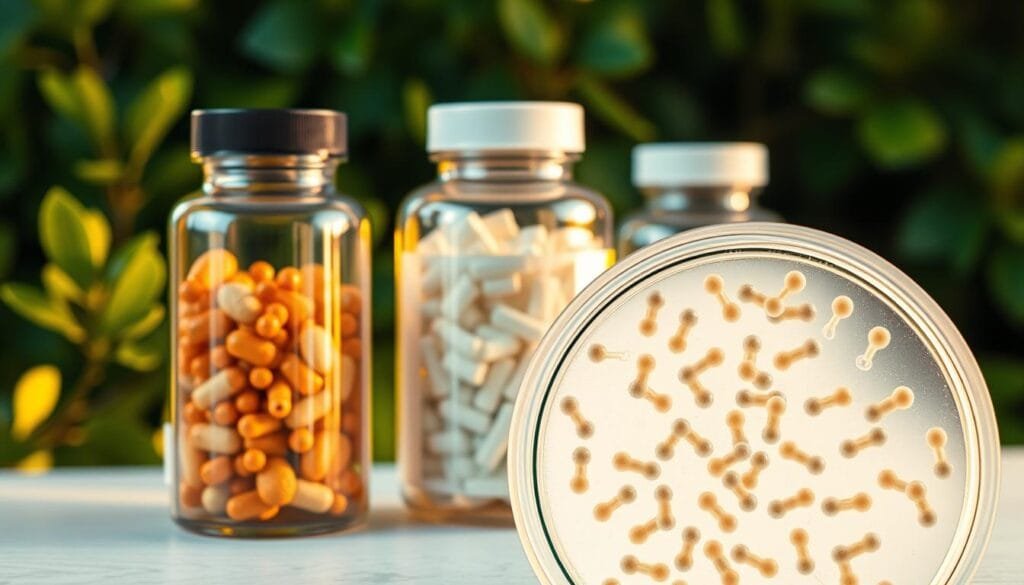Currently Empty: RM0.00
Surprising fact: one well‑designed probiotic product can cut the risk of antibiotic‑associated diarrhea by up to 42% in people who take it alongside antibiotics.
Wellness Concept sets the scene for a simple question many Malaysians ask: what helps those tiny microbes survive from factory to gut, and why does that survival matter for any health benefit?
The article uses the World Health Organization definition: probiotic means live microorganisms that, when given in adequate amounts, confer a health benefit to the host. Strain names and genome data on a product label matter because not all strains perform the same.
Readers will learn which conditions — like acidity and temperature — challenge microorganisms, and which manufacturing and storage choices help them reach the intestine. Wellness Concept frames this as a practical guide. It points to research‑backed tips, label checklists, and smart probiotic use for better gut and overall health.
For product questions and advice in Malaysia, contact Wellness Concept via WhatsApp at +60123822655 during business hours: Mon–Fri 9:30 am–6:30 pm, Sat 10 am–5 pm. Sunday closed.
Key Takeaways
- Survival from factory to gut is essential for any claimed health benefit.
- Look for strain‑level names and evidence on the product label.
- Acidity and temperature matter; formulation and storage protect microbes.
- Wellness Concept offers Malaysia‑focused guidance and WhatsApp support.
- The article uses current research to show practical tips for probiotic use.
Understanding live microorganisms and why survival matters
Understanding what ‘probiotic’ truly means helps separate marketing from science. A clear definition shows why survival from factory to intestine is the first step toward any benefit.

What “probiotic” really means: a probiotic is a product that contains live microorganisms given in adequate amounts to confer health to the host. Without reaching the gut alive, those microorganisms cannot interact with tissues or resident microbes to produce a health benefit host expects.
From microbiome interactions to immune modulation
There are two main ways benefits appear. One route is indirect: certain strains change resident microbial activity. For example, Lactobacillus and Bifidobacterium make organic acids and antimicrobials that limit harmful organisms.
The second route is direct. Some strains signal immune, endocrine, and epithelial cells to lower inflammation and support barrier integrity. Metabolites like short‑chain fatty acids help link local gut effects to whole‑body health.
“Strain identity matters; two strains of the same species can have very different effects.”
- Match product labels to goals and amounts on the pack.
- Look for strain names and human research that support the intended use.
- For friendly guidance in Malaysia, contact Wellness Concept on WhatsApp at +60123822655.
How do bacteria stay alive in probiotics
A product’s pathway from factory to stomach depends on dormancy methods, strain choice, and formulation.
Dormancy explained: Freeze‑drying removes frozen water and pauses metabolic activity so microbes keep life without running energy needs. Low water activity and cool temperature in foods such as yoghurt help maintain this dormant state until rehydration in the gut restarts activity.
Diverse strain categories
Lactic species like Lactobacillus and Bifidobacterium usually need cold storage and gentle acidity. By contrast, endospore‑forming examples such as Bacillus coagulans tolerate wider temperature and pH ranges and reactivate when water and pH are suitable.
Surviving stress and formulation tactics
Acidity, bile, and heat are major stressors. Some product formats use enteric coatings or timed‑release capsules to shield cells. Others are designed as shelf‑stable supplements and list storage on the label.
“pH testing and human clinical trials provide the best evidence that chosen strains reach the gut and work.”
- Freeze‑drying and low water extend shelf life.
- Take a dose with breakfast and food to buffer gastric acidity and boost survival.
- Avoid hot drinks, alcohol, and long heat exposure to preserve viability.
For Malaysian shoppers, Wellness Concept can advise on storage, timing, and suitable products via WhatsApp at +60123822655 (Mon–Fri 9:30 am–6:30 pm; Sat 10 am–5 pm).
How-to choose and use probiotic supplements in Malaysia for maximum benefit
Choosing the right supplement in Malaysia means matching strains, storage and evidence to local conditions.

Reading labels: strain IDs, dose, shelf and evidence
Check full strain IDs (not just species). Look for the live count shown at the end of shelf life.
Seek human trials or clear claims that the product can confer health benefit for specific conditions. Note storage instructions and temperature limits.
Practical usage tips for better results
Many Lactobacillus or Bifidobacterium need refrigeration; endospore examples tolerate broader temperature ranges. If travel or warm rooms are common, pick shelf-stable formats.
- Take a dose with breakfast and food to buffer acidity and improve survival.
- Avoid hot drinks and acidic juices at the same time; keep water handy for capsules.
- Separate supplements from antibiotics by about two hours unless advised otherwise.
- Check best-before dates and allow several days to weeks of regular use before judging effects.
| Feature | What to check | Malaysia tip |
|---|---|---|
| Strain identity | Full strain IDs and supporting trials | Prefer strains with human data for target conditions |
| Shelf stability | Live count at end of shelf life; storage notes | Choose refrigerated for home AC; shelf-stable for travel |
| Formulation | Enteric or timed-release capsules vs food formats | Capsules help routine; food products vary by label clarity |
“Match strains and storage to your routine for the best chance of benefit.”
Wellness Concept supports Malaysian customers via WhatsApp at +60123822655 (Mon–Fri 9:30 am–6:30 pm; Sat 10 am–5 pm). They can advise on local availability, storage and suitable products for specific health goals.
Conclusion
Choosing the right product and routine makes the difference between promise and real benefit. For bacteria to help the host, they must reach the gut alive and regain activity. Selection, storage and timing shape that journey.
Prioritize named strains, clear amounts at end of shelf life, and human evidence when you shop. Note storage notes — refrigeration for sensitive lactic types, shelf‑stable formats for travel — and take doses with breakfast and food to ease acid stress.
Keep daily habits that protect life: store as directed, avoid heat and acidic drinks around dosing, and monitor effects over days or weeks. For personalised guidance in Malaysia, message Wellness Concept on WhatsApp at +60123822655 (Mon–Fri 9:30 am–6:30 pm; Sat 10 am–5 pm; Sunday closed) for tips on reading labels and protecting viability from store to stomach.
FAQ
What does "probiotic" mean?
The term refers to live microorganisms that, when consumed in adequate amounts, confer a health benefit on the host. Common examples include strains of Lactobacillus and Bifidobacterium used in food products and supplements.
Why does survival of these microbes matter?
Survival matters because microbes must remain active through manufacturing, storage, and passage through the stomach to reach the gut and exert effects like supporting digestion and immune modulation.
How does dormancy help microbes survive production and storage?
Many strains are freeze-dried to enter a dormant state with low water activity. This preserves viability until rehydration in the gut or with liquid restores metabolic activity and function.
Which strains are known for being hardy?
Lactobacillus and Bifidobacterium are common and effective. Some Bacillus species form endospores that tolerate heat and acidity better, making them useful in certain supplements and shelf-stable products.
What challenges do microbes face in the digestive tract?
They must survive stomach acidity, bile salts, and digestive enzymes. Robust strains and protective formulations help more organisms reach the intestines alive.
What formulation tactics increase survival?
Manufacturers use refrigeration, moisture-proof packaging, enteric coatings, and timed-release capsules. Proper storage instructions on the label help maintain shelf stability and potency.
When is the best time to take a supplement for improved survival?
Taking a supplement with breakfast or a meal can buffer stomach acid and improve survival. Specific timing may vary by product, so users should follow label directions.
How do researchers confirm microbes reach the gut alive?
Evidence comes from pH tolerance tests, simulated digestion studies, and human clinical trials that measure strain recovery in stool or demonstrate clinical benefits.
What should consumers look for on a label?
Check for clear strain identifiers, colony-forming unit (CFU) counts at the end of shelf life, storage guidance (refrigerated or shelf-stable), and references to clinical evidence supporting the product.
Any practical tips for storing and using supplements?
Avoid heat and humidity, don’t mix probiotics with very hot drinks or acidic beverages like grapefruit juice, keep a safe interval from antibiotics unless advised, and check the expiration or manufacturing date for potency.
Are food sources better than capsules?
Fermented foods like yogurt, kefir, kimchi, and tempeh provide live cultures within a food matrix that can help survival and offer additional nutrients. Supplements offer specific strains and controlled doses when targeted benefits are needed.
How many live organisms are needed for an effect?
Effective doses vary by strain and condition. Labels express counts in CFUs; clinical trials guide recommended amounts. Consumers should choose products with documented dosing from reputable brands and studies.
Do probiotics interact with health conditions or medications?
Most healthy people tolerate probiotics well, but those with serious illnesses, weakened immune systems, or on complex treatments should consult a healthcare professional before use.
How can someone in Malaysia pick the right supplement?
Read labels for strain IDs and evidence, follow storage instructions for local climate, choose established brands with transparent testing, and consider refrigerated options if recommended.



